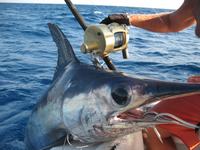swede0418
Newbie level 5
hello, i would like to first introduce myself. my name is Tom, i am trying to perfect my fishing reel i recently invented a little over a year ago. i love to learn about electronics and this simple project is making me crazy. i would hope that someone could shed some light on my issue. i recently decided to install a simple digital counter to my fishing reels to display the amount of line that is out. my hope is to build an inexpensive counter that will add, subtract sense direction and reset to zero with a press of a button. the counter needs to count at speeds of 1000 rpm's. also i would like to count 1 time per 2 revolutions. so basically i found this trumeter 7000as i would like to work with except i can't figure out what i need to do to get it to sense direction. i can get it to add using a magnet and a hall effect sensor, but it adds turning in both directions. i would like to work with this counter display, unless you have a better one to suggest. i like this counter because the company is in my back yard. if any one could help me solve this issue i would greatly appreciate it.
thanks
Tom

thanks
Tom


